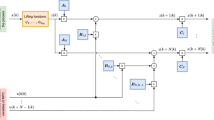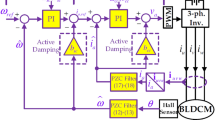Abstract
Stick-slip vibrations appear during relative motion between contacting surfaces of miscellaneous frictional pairs. They depend on the viscous force, Coulomb force or other velocity-dependent forces. These effects appear in almost all mechanical systems, for instance, in positioning systems like servomechanisms, impulse encoders and stepper motors which operate at, or about zero velocity of relative motion between shafts and sliding bearings. This paper presents numerical modelling of a DC-motor as a dynamical system with stick-slip effect which appears while direction of rotation of its rotor crosses zero velocity speed. These investigations are aimed on some future applications of the control technique serving for explanation of bifurcation phenomena existing in such kind of discontinuous systems. Putting emphasis on nonlinear effects we apply the well-known, but a bit extended sliding-surface method allowing for compensation of frictional effects. A limit cycle on a phase plane as well as time-histories of control inputs and system outputs were obtained using numerical simulations performed in Simulink.
Similar content being viewed by others
References
Adams J., Payandeh S.: Methods for low-velocity friction compensation: theory and experimental study. J. Robot. Syst. 13(6), 391–404 (1996)
Awrejcewicz J., Olejnik P.: Stick-slip dynamics of a two-degree-of-freedom system. Int. J. Bifurcation Chaos 13(4), 843–861 (2003)
Awrejcewicz, J., Olejnik, P.: Sliding solutions of a simple two degrees-of-freedom dynamical system with friction, Proceedings of 5-th EUROMECH, Nonlinear Dynamics Conference ENOC2005, Eindhoven, August 7–12, 631–640 (2005)
Awrejcewicz J., Olejnik P.: Analysis of dynamic systems with various friction laws. Appl. Mech. Rev. Trans. ASME 58(6), 389–411 (2005)
Cai L., Song G.: Jointstick-slip friction compensation of robot manipulators by using smooth robust controllers. J. Robot. Syst. 11(6), 451–470 (1994)
Chiason J.: A new approach to dynamic feedback linearization control of an induction motor. IEEE Trans. Automat. Control 43(3), 391–397 (1997)
Chenafa M., Mansouri A., Bouhenna A., Etien E., Belaidi A., Denai M.A.: Global stability of linearizing control with a new robust nonlinear observer of the induction motor. Int. J. Appl. Math. Comput. Sci. 15(2), 235–243 (2005)
Driessen B.J., Sadegh N.: Convergence theory for multi-input discrete-time iterative learning control with Coulomb friction, continuous outputs, and input bounds, Int. J. Adapt. Control Signal Process. 18, 457–471 (2004). doi:10.1002/acs.807
Heckl M.A., Abrahams I.D.: Active control of friction-driven oscillations. J. Sound Vib. 193(1), 417–426 (1996)
Hirschorn R.M., Miller G.: Control of nonlinear systems with friction. IEEE Trans. Control Syst. Technol. 7(5), 588–595 (1999)
Huang S.N., Tan K.K., Lee T.H.: Adaptive friction compensation using neural network approximations. IEEE Trans. Syst. Man. Cybern. 30(4), 551–557 (2000)
Kim Y.H., Lewis F.L.: Optimal design of CMAC neural network controller for robot manipulators. IEEE Trans. Syst. Man. Cybern. 30(1), 22–31 (2000)
Lewis F.L., Abdallah C.T., Dawson D.M.: Control of Robot Manipulators. Macmillan Publishing Company, New York (1993)
Li Z., Wang Q., Gao H.: Friction driven oscillator control by Lyapunov redesign based on delayed state feedback. Acta Mech. Sin. 25, 257–264 (2009). doi:10.1007/s10409-008-0181-y
Lin C.-L., Huang H.-T.: Linear servo motor control using adaptive neural networks, Proc. Instn. Mech. Eng. 216, 407–427 (2002)
Lubineau D., Dion J.M., Dugard L., Roye D.: Design of an advanced non linear controller for induction motors and experimental validation on an industrial benchmark. EPJ Appl. Phys. 9, 165–175 (2000)
Mansouri A., Chenafa M., Bouhenna A., Etien E.: Powerful nonlinear observer associated with the field-oriented control of the induction motor. Int. J. Appl. Math. Comput. Sci. 14(2), 209–220 (2004)
Marino R., Peresada S., Valigi P.: Adaptive input-output linearizing control of induction motors. IEEE Trans. Automat. Control 38(2), 208–221 (1993)
Otten G., de Vries T.J.A., van Amerongen J., Rankers A.M., Gaal E.W.: Linear motor motion control using a learning feedforward controller. IEEE/ASME Trans. Mechatron. 2(3), 179–187 (1997)
Slotine J.-J.E., Li W.: On the adaptive control of robot manipulators. Int. J. Robot. Res. 6(3), 49–59 (1987)
Song G., Cai L., Wang Y., Longman R.W.: A sliding-mode based smooth adaptive robust controller for friction compensation. Int. J. Robust Nonlinear Control 8, 725–739 (1998)
Author information
Authors and Affiliations
Corresponding author
Rights and permissions
About this article
Cite this article
Olejnik, P., Awrejcewicz, J. Low-Speed Voltage-Input Tracking Control of a DC-Motor Numerically Modelled by a Dynamical System with Stick-Slip Friction. Differ Equ Dyn Syst 21, 3–13 (2013). https://doi.org/10.1007/s12591-012-0114-x
Published:
Issue Date:
DOI: https://doi.org/10.1007/s12591-012-0114-x




